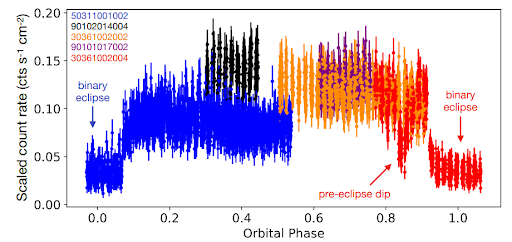Title: Extending the baseline for SMC X-1’s spin and orbital behavior with NuSTAR stray light
Authors: McKinley C. Brumback, B.W. Grefenstette, D.J.K. Buisson, M. Bachetti, R. Connors, J.A. Garcia, A. Jaodand, R. Krivonos, R. Ludlam, K.K. Madsen, G. Mastroserio, J.A. Tomsick, D. Wik
First Author’s Institution: Cahill Center for Astronomy and Astrophysics, California Institute of Technology
Status: Submitted to the Astrophysical Journal [open access on the arXiv]

A new study of an astronomical source emitting X-rays has been performed entirely using the power of stray cats… or should I say, StrayCats! StrayCats is a database of stray X-rays picked up by the Nuclear Spectroscopic Telescope Array (NuSTAR) satellite, an astronomical X-ray observatory orbiting the Earth. Typically, astronomers observe a source by pointing directly at it, but because of the way NuSTAR was constructed, it’s possible to pick up “stray” photons from unintended sources close to the target. Figure 1 to the right shows the optical setup of NuSTAR, with gaps between the apertures (which focus the incoming light) and the detector (which converts the X-rays into electrical signals and sends them to the computer). The red lines show the path of stray light passing through the gaps between the apertures to land on the detector, and show how light from sources slightly offset from the pointing focus of the satellite can still land on the detector.
The detectors on NuSTAR are sophisticated enough to be able to tell where these stray X-ray photons are coming from. The details of each detection of stray light is stored in a dedicated database– the StrayCats catalog. This paper reports the first scientific study of an astronomical object solely using stray light data!
Look What the Cat Dragged In!
The source in question is SMC X-1, a binary system containing a neutron star in an orbit with a supergiant star, with a mass 18 times that of our Sun. We call these sources High-Mass X-ray Binaries (HMXBs)– simply because their companions are heavy, and they emit X-rays! The name SMC X-1 indicates that it’s in the Small Magellanic Cloud (SMC), an irregular galaxy orbiting the Milky Way, and that it was the first X-ray source discovered there, back in 1971. Because it’s so bright, and it’s in a dense environment with lots of other objects, light from SMC X-1 is typically picked up by NuSTAR whenever it’s pointing somewhere in the SMC.
This is especially helpful for this source since it’s a binary– determining the exact parameters of a binary system is super tough, requiring lots of densely spaced observations over a long period of time. The StrayCats catalog essentially allows for ‘free’ observations of the source, allowing researchers to study the motion of the binary system.
StrayCats: A Paw-erful Astronomical Tool
Before this analysis was even done, a lot was known about SMC X-1: we see constant X-ray emission from the source as well as brighter pulses of X-rays every 0.7 seconds, which is the rotation period of the neutron star. We associate all of this with a process known as accretion, where material from the companion star gets pulled onto the neutron star. This causes the neutron star to rotate faster and faster, but the infalling material also heats up parts of the neutron star hot enough to emit X-rays, causing the X-ray pulsations we see as it spins.
We also see the signal get much dimmer during certain points in the 3.9 days it takes for the binary to make a complete orbit. This “eclipsing” behavior is typical of binary systems, when the companion star gets between the neutron star and the observer and blocks the signal. These stray light observations were taken at all different points during SMC X-1’s orbit, and the authors were able to confirm that the eclipsing behavior has not changed since the previous study in 2019 (see Figure 2).


Finally, the authors studied the pulse profile, or the strength of the emission across the rotation of the neutron star (as opposed to the revolution of the pulsar and the companion star, shown in Figure 2). Pulse profiles can teach us a lot about the region immediately surrounding the neutron star, and the physics which creates the emission we see. These stray light observations revealed an interesting new property of SMC X-1’s pulse profile: as the neutron star exits its eclipsing state, its pulse profile seems to change a lot. Figure 3, on the left, shows the pulse profile in several different time chunks immediately after the eclipse, and as the neutron star leaves the eclipse (in the figure, moving from top to bottom), the profile becomes brighter and the relative strength of each component of the profile changes.
Overall, this study is an excellent proof of concept that the StrayCats database can be used for scientific studies without help from targeted observations. This opens up a whole new window of possible astronomical sources to observe without having to propose for observing time– especially helpful when using a satellite which wasn’t designed to quickly rotate to point at specific sources. In the future, herding these stray cats will teach us even more about the wide variety of X-ray sources in the sky!
Astrobite edited by Viraj Karambelkar
Featured image credit: NASA/JPL-Caltech; Sergey Taran




